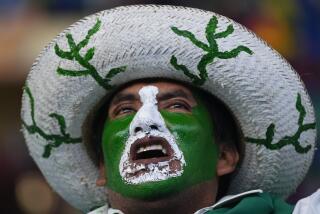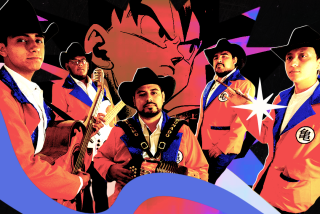Amid the Concrete of Modern Bolivia, Ancient Aymara Culture Blooms
- Share via
LA PAZ, Bolivia — As La Paz has grown into a bustling city of more than 1 million people, with shining skyscrapers and noisy traffic jams, an urban Indian subculture has flourished amid the concrete and brick, preserving its folk customs, traditional beliefs and ancient language against the pressure of the dominant culture and the modern metropolitan environment.
The streets of La Paz belong to the cholitas, Indian women in bowler hats, full skirts and brightly colored shawls who come and go with babies and bundles on their backs, or sit on sidewalks peddling food, trinkets and gadgets. Aymara-speaking Indians also own uncounted shops and other businesses in the city, and their children are moving up in the mainstream educational system.
Some eventually assimilate into the Spanish-speaking mainstream, but the urban Indian masses, now a majority in the La Paz metropolitan area, are continually augmented by migrants from rural areas. And a growing elite of educated Aymaras is working to strengthen their subculture.
‘Water and Oil’
Aymara anthropologist Mauricio Mamani said that after centuries of discrimination against Indians by the city’s Spanish-speaking elite, La Paz’s two separate societies will never unify.
“Impossible,” he said in an interview, “because they are like water and oil. It is not possible for them to come together.”
Aymara Indians once lived in a proliferation of independent rural kingdoms spread over the Andean highlands. They were linked by their common language and similar cultural patterns. In the 1400s, the Quechua-speaking Incas conquered the kingdoms, but the Aymara language and culture endured. In the 1500s, Spanish domination began.
Over the centuries, the Aymaras have learned Spanish, accepted Catholicism and adopted many of the cultural trappings of the conquerors and their descendants. The bowler hats and full skirts worn by Aymara women came from Europe.
Longtime Duality
There have been urban Indians since La Paz was founded. Built in rectangles around a central square, the colonial city was flanked by Indian huts huddled along irregular lanes. The Indians called La Paz by an Aymara name, Chukiyawu.
“There has been a duality in the city since its foundation,” said Jose Mesa, director of the Museum of Customs.
In 1781, Aymara Indians led by Tupac Katari laid siege to La Paz for several months as part of a failed Andean rebellion against Spanish domination. After Bolivia’s independence in 1825, the country’s white and mixed-race ruling classes intensified efforts to suppress Indian culture and customs.
“There was a reaction against things indigenous,” Mesa said. “But the Indians did not abandon what was theirs.”
Official discrimination waned slowly. A 1925 decree by the municipal government of La Paz, barring Indians from the areas near the city’s main square, was not revoked until 1944.
Migration Pattern
The Bolivian revolution of 1952 further reduced official discrimination against Indians. After the revolution, when La Paz had a population of less than 150,000, a rapid flow of migration from rural Indian villages began.
“Those who arrived from the countryside found a kind of urban Aymara culture,” said Father Xavier Albo, a priest who has studied the urban Indians. A solid community of Aymaras who know the ways of the city yet retain many rural customs has eased the transition of new migrants into urban life.
Several La Paz radio stations broadcast throughout the day in Aymara, with music, news and commentary attuned to the Indian culture. “This fact consolidates a kind of Aymara culture, but urban Aymara,” said Albo.
Urban Aymara music is heavier on brass than the rural music, which is played on various pipe instruments. Likewise, urban Indians are brassier in their quest for social status and economic gain, while rural Aymaras “underline more equality, sharing, generosity,” Albo said.
Among urban Indian women, coveted status symbols include expensive vicuna shawls with gold brooches and bowler hats imported from Italy. City styles for skirts and shawls eventually become popular among those who can afford them in rural villages.
Rural religious rituals, often mixing ancient Indian beliefs with Catholicism, have been adapted to the city. The rural deity Pacha Mama, or Mother Earth, is a major figure in urban Indian life, requiring ceremonial offerings called ch’allas. But the purpose of the urban ceremony is altered.
“They no longer do it for the fertility of the Earth but for the multiplication of money,” Albo said.
Another popular deity, called Ekeko, is represented by a stubby doll with a round, smiling face, carrying a bag loaded with miniaturized material goods such as food, furniture, appliances and money, cars and even houses. For a religious fiesta in January called Alasitas, La Paz’s Aymaras and non-Aymaras alike buy the miniatures representing things they hope to acquire during the year.
Busy Streets
Although most urban Indians are poor, as indicated by large numbers of Aymara street vendors and housemaids, some are increasingly prosperous. Aymara areas are known for their teeming markets and busy business streets. One of the most important streets, Avenida Buenos Aires, is lined with Aymara-owned buildings several stories high and often congested with bumper-to-bumper traffic. It is not uncommon to see Indian women in bowler hats driving cars and trucks.
“The Aymaras have monopolized all small commerce,” said historian Luis Oporto. Many Indian merchants have become wealthy, he said, and “their children can study in the most expensive schools.”
Oporto said that a friend of his is going to marry an Aymara truck owner and that they are planning a lavish wedding that will last three days. “They have invited 500 people,” he said. “There will be three orchestras in a giant locale.”
But no matter how much money an Aymara has, he will continue to be considered an Indian by the Bolivian middle and upper class, according to Oporto.
“In the fiestas of the petit bourgeoisie, the Bolivian bourgeoisie, Aymaras aren’t present,” he said. “It is impossible. . . . In reality, there continues to be discrimination, notable discrimination.”
Only when the Indians become Westernized does the discrimination end, Oporto said. And little by little, from generation to generation, the urban Indians “slowly are becoming Western citizens.”
To counter the process of cultural assimilation, educated Aymaras have begun organizing a movement to promote Aymara pride. Aymara broadcasters, historians, teachers and others have formed ethnic guilds and associations. Aymara university students who once had rejected their cultural heritage have joined the movement, Oporto said.
“I think it has been understood, even at the government level, that it would not be right to lose the culture,” he said.
For Jorge Quisque, 40, there has never been any question about that. He and his wife came to La Paz 20 years ago from a highland village. They have four children, ages 8 to 19. All have learned Aymara as well as Spanish.
Daughters Study
“They speak both perfectly,” the father said proudly. One of his sons is a bus driver, the other works in an auto body shop, and his two daughters are students.
Quisque sells electric sockets, plugs, switches and tape on La Paz’s main avenue, called the Prado. Wearing a light jacket and a red Coca-Cola cap, he sat on a step behind a display of his wares, spread over a square of blue plastic on the sidewalk.
At home, the family observes “the customs that we learned from our grandparents,” he said. For example, they make ch’allas for the new year and before Lent, usually using beer instead of liquor for the offerings because “there isn’t money for much.”
They maintain their ties to their native village, in the province of Sorate, and save money to take their turn contributing to fiestas there. “The town requires it, so you have to do it,” he said.
More to Read
Sign up for Essential California
The most important California stories and recommendations in your inbox every morning.
You may occasionally receive promotional content from the Los Angeles Times.













